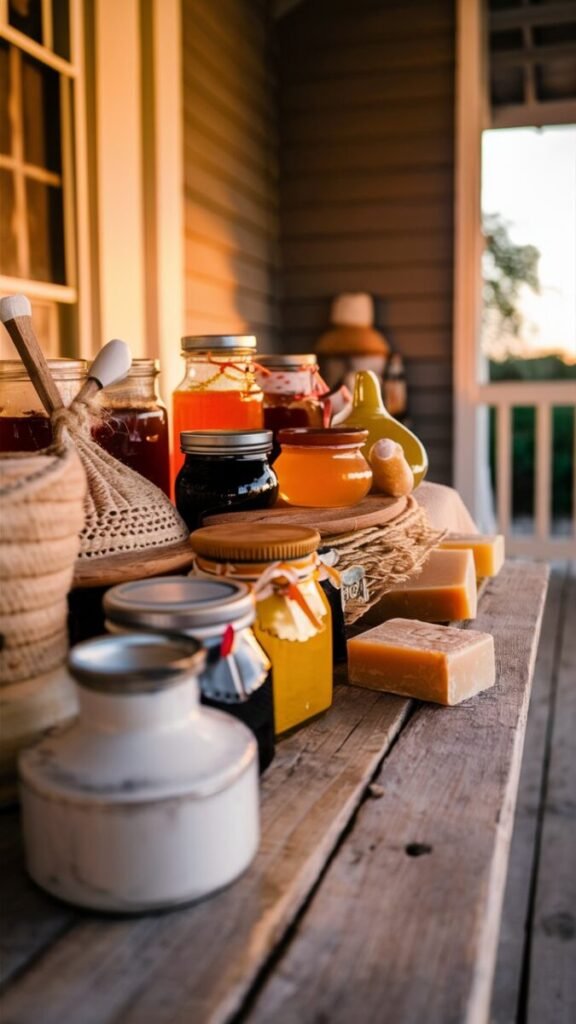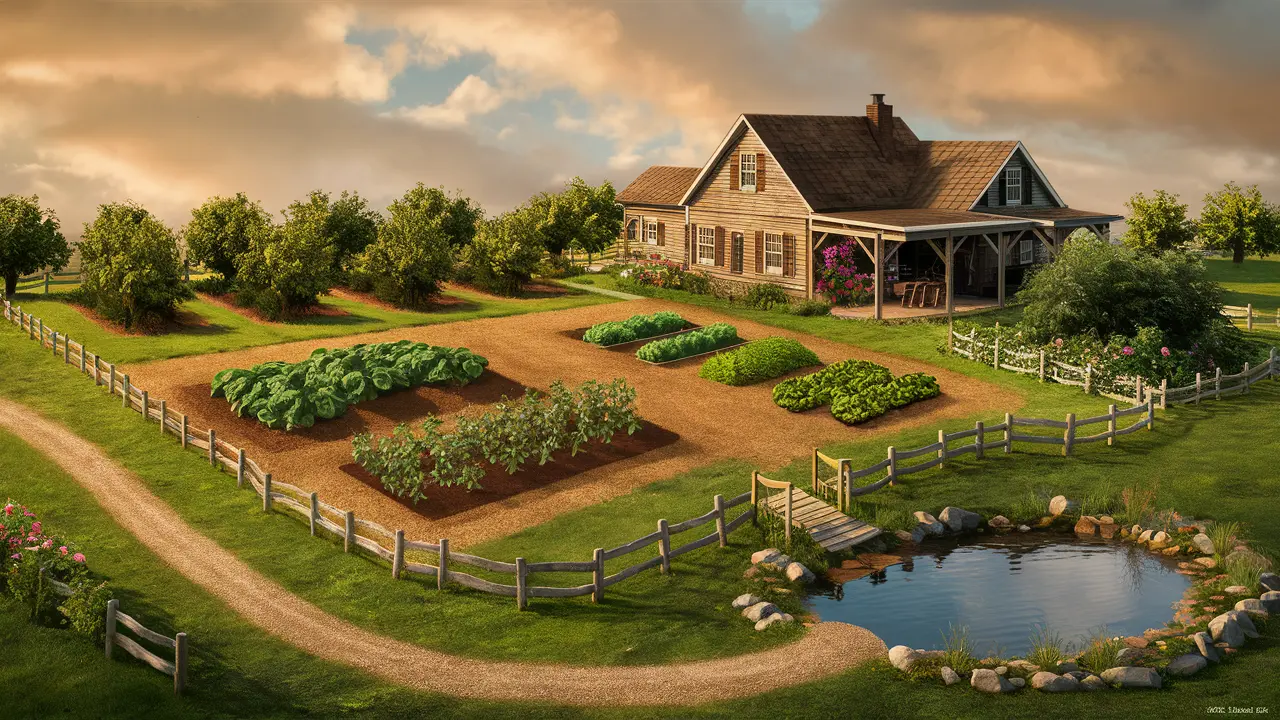Homesteading on a small acreage has gained immense popularity among those prepping for survival.
With meticulous planning and a comprehensive understanding of sustainable living practices, it is entirely possible to create a thriving homestead on just one acre of land.
This article explores strategies to maximize your limited space, utilize low-impact farming techniques, and implement innovative approaches to achieve a self-sufficient lifestyle. This lifestyle ensures your family’s preparedness in the face of adversity.
Table of Contents
Planning Your 1-Acre Homestead


Effective planning is the foundation of a successful 1-acre homestead.
Carefully assess your land’s unique characteristics and resources to optimize your layout and ensure efficient utilization of every square foot.
- Zoning and Layout:
- Divide your property into distinct zones based on sun exposure, drainage, and accessibility.
- Place structures, gardens, and livestock areas strategically for optimal functionality.
- Microclimates and Resource Assessment:
| Factor | Consideration |
|---|---|
| Sun Exposure | Identify areas with full sun, partial shade, and full shade for crop/plant placement. |
| Water Availability | Assess natural water sources, rainwater harvesting potential, and well drilling feasibility. |
| Soil Quality | Conduct soil tests to determine necessary amendments for optimal fertility. |
| Wind Patterns | Understand prevailing winds for windbreak and structure placement. |
- Goal Setting:
- Determine your priorities: self-sufficiency, supplemental income, or a combination of both.
- Establish realistic goals based on your resources, skills, and time constraints.
- Start small and gradually expand as you gain experience.
Meticulous planning of your 1-acre homestead allows you to create a harmonious and efficient environment.
This environment supports your survival preparedness goals, minimizes resource waste, and maximizes productivity.
Livestock Options for a Small Homestead

Incorporate livestock into your 1-acre homestead to provide a valuable source of sustenance, income, and self-sufficiency.
Choose species that align with your space constraints and specific needs.
Poultry:
- Chickens: Opt for smaller breeds like Serama or Cubalaya for fresh eggs and meat.
- Quail: Prolific egg layers that require minimal space (1 sq. ft. per quail).
Small Ruminants:
- Goats: Consider miniature or dwarf goats for milk, cheese, and brush control.
- Sheep: Provide wool and milk, but in smaller quantities than goats.
Rabbits:
- Compact and prolific, ideal for meat production, fur, and nutrient-rich manure.
Bees:
- Enhance pollination, produce honey and wax for personal use or income.
- Require minimal space and daily care.
Aquaculture:
- Raise fish like tilapia in ponds or stock tanks for food.
- Implement aquaponics systems for integrated plant and fish production.
| Livestock | Space Requirement | Primary Benefits |
|---|---|---|
| Chickens | 4-6 sq. ft. per bird | Eggs, meat, manure |
| Quail | 1 sq. ft. per bird | Eggs, meat, manure |
| Goats | 200-400 sq. ft. per goat | Milk, cheese, brush control |
| Rabbits | 4-6 sq. ft. per rabbit | Meat, fur, manure |
| Bees | 2-4 hives | Pollination, honey, wax |
Carefully select the right livestock for your homestead to diversify your food sources, generate supplemental income, and enhance the overall sustainability of your survival preparedness efforts.
Maximizing Your Garden Space

Maximizing your garden’s productivity is paramount in a limited space.
Implement space-saving techniques and embrace innovative growing methods to ensure a bountiful harvest year-round.
Raised Beds and Square Foot Gardening:
- Optimize soil quality and drainage.
- Facilitate intensive planting and crop rotation.
- Minimize soil compaction and weed growth.
Companion Planting:
- Strategically pair plants that benefit each other’s growth and deter pests.
- Example: Plant marigolds with tomatoes to repel nematodes and improve soil quality.
Vertical Gardening and Trellising:
- Utilize vertical space for vining crops like cucumbers, tomatoes, and pole beans.
- Install trellises, cages, or tepee structures for support.
Intensive Planting and Succession Planting:
- Plant crops in close proximity, maximizing yield per square foot.
- Continuously replant spaces as crops are harvested.
Cold Frames and Season Extension:
- Extend the growing season with cold frames or low tunnels.
- Start seeds earlier and protect tender plants from frost.
Implementing these space-saving techniques optimizes your garden’s productivity. You can ensure a steady supply of fresh, nutrient-dense produce for your family’s survival preparedness needs.
Incorporating Fruit Trees and Berries

Fruit trees and berry bushes are invaluable additions to any 1-acre homestead.
They provide a sustainable source of nutrient-rich fruits while requiring minimal maintenance once established.
Dwarf and Semi-Dwarf Varieties:
- Perfect for small spaces, easier to prune and harvest.
- Examples: Dwarf apple, pear, and cherry trees.
Pruning and Espalier Techniques:
- Train trees to grow flat against a trellis or wire, saving space.
- Espalier patterns like fan or cordon can be visually appealing.
Edible Landscaping and Food Forests:
- Incorporate fruit trees and berry bushes into your landscape design.
- Mimic natural ecosystems by layering plants for optimal space utilization.
Berry Bushes and Cane Fruits:
- Blueberries, raspberries, and blackberries provide nutrient-dense fruits.
- Can be grown in containers or raised beds for space-saving.
Thoughtfully incorporating fruit trees and berry bushes into your homestead layout creates a diverse and resilient food system.
This supports your family’s survival preparedness goals while adding beauty and functionality to your landscape.
Essential Homestead Structures

Efficient and multipurpose structures are crucial for maximizing productivity and organization on your 1-acre homestead.
Multi-purpose Outbuildings and Barns:
- Provide shelter for livestock and equipment storage.
- Consider integrating workshops or potting areas.
Greenhouses and Season Extension:
- Extend the growing season and start seedlings earlier.
- Options: Traditional greenhouses, hoop houses, or cold frames.
Root Cellars and Food Storage:
- Ensure proper storage of crops for year-round access.
- Alternatives: Pantries, cellars, or cool, dark rooms.
Composting Systems:
- Recycle organic waste into nutrient-rich soil amendments.
- Options: Bins, tumblers, or open-air piles.
| Structure | Primary Function | Space Requirement |
|---|---|---|
| Outbuilding | Livestock shelter, equipment storage | 200-400 sq. ft. |
| Greenhouse | Season extension, seedling propagation | 100-300 sq. ft. |
| Root Cellar | Food storage | 50-100 sq. ft. |
| Compost Bin | Organic waste recycling | 4-9 sq. ft. |
Strategically incorporating these essential structures into your homestead design streamlines operations, reduces waste, and ensures a consistent supply of fresh produce and preserved goods for your family’s survival preparedness needs.
Water and Energy Management

Sustainable water and energy management are critical components of a self-sufficient 1-acre homestead, particularly in the context of survival preparedness.
Rainwater Harvesting and Greywater Systems:
- Collect and store rainwater for irrigation and household use.
- Reuse greywater from sinks and showers for non-potable purposes.
Solar Power and Wind Energy Solutions:
- Invest in solar panels or small-scale wind turbines for renewable energy generation.
- Combine with battery storage systems for uninterrupted power supply.
Well Drilling and Water Catchment Systems:
- Explore the feasibility of drilling a well for a reliable water source.
- Implement water catchment systems like ponds or cisterns.
Efficient Irrigation Techniques:
- Utilize drip irrigation or soaker hoses to minimize water waste.
- Implement mulching to retain soil moisture and reduce evaporation.
Implementing these sustainable water and energy management strategies reduces your reliance on external resources and minimizes your environmental impact. These strategies ensure a resilient homestead capable of withstanding disruptions to traditional utility systems.
Generating Income from Your Small Homestead

While self-sufficiency is a primary goal for many homesteaders, generating supplemental income from your 1-acre property can enhance your survival preparedness and financial resilience.
Value-Added Products:
- Develop and sell value-added products like jams, honey, soap, or baked goods.
- Leverage your homestead’s unique offerings and local demand.
Farm-to-Table Experiences and Agritourism:
- Offer farm tours, cooking classes, or farm-stay experiences.
- Capitalize on the growing interest in sustainable living and local food.
Community Supported Agriculture (CSA) Programs:
- Provide weekly shares of fresh produce, eggs, or other farm products.
- Establish a loyal customer base and foster community connections.
Cottage Industries and Crafts:
- Utilize your skills and resources to produce and sell handmade crafts or artisanal items.
- Examples: Woodworking, pottery, textile arts, or herbalism.
Diversifying your income streams and tapping into the growing demand for locally sourced, sustainable products and experiences enhances your financial resilience.
This ensures a stable economic foundation for your family’s survival preparedness efforts.
Tips for Successful Small-Scale Homesteading

Homesteading on a small acreage can be rewarding yet challenging. Ensure long-term success by embracing these essential tips:
Time Management and Prioritization:
- Develop a realistic schedule that balances homesteading tasks with other responsibilities.
- Prioritize essential tasks and delegate or outsource when necessary.
Embracing Simplicity and Minimalism:
- Avoid overextending yourself by focusing on core homesteading activities.
- Simplify systems and processes for greater efficiency and sustainability.
Building a Supportive Community:
- Connect with local homesteading groups or online forums for advice and support.
- Collaborate with neighbors for resource sharing or bartering opportunities.
Continuous Learning and Adaptation:
- Stay up-to-date with evolving best practices and techniques.
- Be open to adapting your strategies based on experience and changing circumstances.
Mindful Resource Management:
- Implement conservation practices for water, energy, and soil resources.
- Reuse, recycle, and repurpose materials whenever possible.
Embracing these principles and fostering a growth mindset helps navigate the challenges of small-scale homesteading.
This creates a resilient, self-sufficient lifestyle that supports your family’s survival preparedness goals.
Conclusion
Homesteading on 1 acre is achievable with careful planning, innovative techniques, and a commitment to sustainable living.
Maximize your limited space, incorporate diverse livestock and crop options, and implement efficient water and energy management strategies.
This ensures a reliable supply of food, water, and resources for your family’s survival preparedness needs.
Small-scale homesteading is a journey of continuous learning and adaptation.
Embrace simplicity, foster a supportive community, and remain open to evolving your strategies as you gain experience.
With perseverance and dedication, your 1-acre homestead can become a resilient oasis, equipping you with the skills and resources to navigate even the most challenging circumstances.


